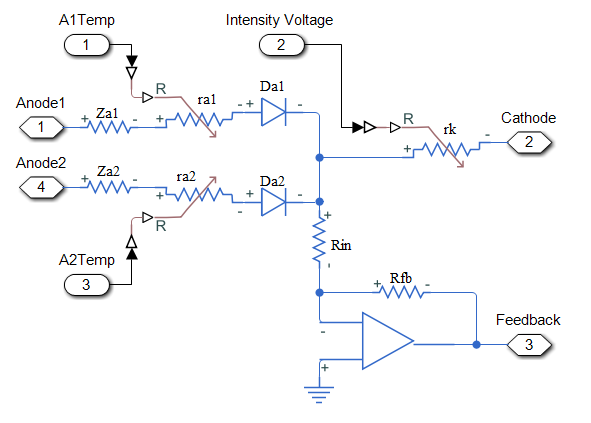Ring Laser Gyros: Improving Precision and Accuracy Through Soft-Core Processor-Based Active Current Balance Control Approach- Simulation and Implementation Results
Main Article Content
Abstract
In this article, we intend to demonstrate on digital active current control in ring laser gyros (RLG). The specific source errors that effect the performance of laser gyro is discussed. This work proposes a system of digital detection and control system to address deficiencies of the conventional analog circuits. The hardware framework is constructed using the Field Programmable Gate Array (FPGA) and the required analog interface, which incorporates driving and acquisition circuitry for the specific physics of gyros. The software flow is provided in full and uses the parallel PI (proportional-integral) control algorithms. The outcomes demonstrate that the precision of anode currents are accurately controlled within ±0.1µA along with cathode voltage, demonstrating that the performance of the digital system is superior to that of analog circuits, which will be very beneficial for the laser gyro application. The simulation results prove that the proposed approach has good result of balancing anode currents, meanwhile, it makes the sensor a good dynamic performance. In both anodes, the experimental findings are contrasted with balanced and unbalanced currents. The optimal constant current is obtained from the remarkable agreement between simulated and experimental results.
Article Details
References
Frederick Aronowitz, “Fundamentals of the Ring Laser Gyro”, in Optical gyros and their application, BP 25, 7 Rue Ancelle, F-92201 Nueilly-Sur-Seine Cedex, France, 1999, pp. 3.1-3.15.
Woo-Seok Choi, Kyu-Min Shim, Kyung-Ho Chong, Jun-Eon An, Cheon-Joong Kim and Byung-Yoon Park. Sagnac Effect Compensations and Locked States in a Ring Laser Gyroscope. Optical Sensors.3 February 2023. DOI: 10.3390/s23031718.
I. L. Paiva, R. Lenny, and E. Cohen. Geometric phases and the Sagnac effect: Foundational aspects and sensing applications. Advanced Quantum Technologies. 15 Jan 2022. DOI: 10.1002/qute.202100121.
Bhadra, A., Ghose, S. & Raychaudhuri, B. A quest for the origin of the Sagnac effect. The Europian Physical Journal. J. C 82, 649 (2022). DOI:10.1140/epjc/s10052-022-10620-6.
Tevfik Ozan Fenercio?lu and Tuncay Yalçinkaya. Computational–Experimental Design Framework for Laser Path Length Controller. Sensors, Jul 31, 2021. DOI: 10.3390/s21155209.
P.F.Lan, Y.Z.Liu, J.L.Wang, M.H.Zhang. Research and improvement of path length control configuration for laser gyroscopes. An article. Volume 34. pp: 161-165.Jan 2013. DOI:10.5768/JAO201334.0107004.
Modular Ring Laser Gyro, by Joseph E. Killpatrick and Dale Berndt. (2001, March 27), Patent 6208414B1.
Faucheux Marc, D.Fayoux, J.J. Roland. Ring Laser Gyro,December 2000, Journal of Optics 19(3):101. DOI:10.1088/0150-536X/19/3/001.
Angela D. V. Di Virgilio, Nicolò Beverini, Giorgio Carelli, Donatella Ciampini, Francesco Fuso & Enrico Maccioni. Analysis of ring laser gyroscopes including laser dynamics. The European Physical Journal C, volume 79, Article number: 573 (2019). DOI:10.1140/epjc/s10052-019-7089-5.
Loren W. Richardson, “Ring laser gyro applications for high accuracy pointing and tracking in space”, SPIE’s International Symposium on Optical Engineering and Photonics in Aerospace Sensing, Orlando, FL, USA, 1994.
G. Gilster, “High accuracy performance capabilities of the military standard ring laser gyro inertial navigation unit”, 1994 April, 1994, PLANS’94.
Mario. N. Armenise, C. Ciminelli, F. Dell’Olio, and V. M. N. Passaro, “He-Ne and Solid-State Ring Laser Gyroscopes”, in Advances in Gyroscope Technologies. 1st ed, Springer Berlin, Heidelberg, 2011,ch. 3, pp17-28.
Zhenfang Fan, Hui Luo, Shaomin Hu, Guangzong Xiao, “Research on lock-in correction for mechanical dithered ring laser gyro”, Optical Engineering, Vol.50, No. 3, 034403, 1 March 2011.
Zhenfang Fan, Hui Luo, Guangfeng Lu, Shaomin Hu, “Direct dither control without external feedback for ring laser gyros”, in Optics and Laser Technology. Changsha, China, Vol 44, Issue4, June 2012, pp 767-770.
S M Yang and J S Chiu, “Dither-motor design with concurrent sensing and actuating piezoelectric materials” Smart materials and Structures, vol 3, no 2, IOP publishing, 1994. DOI 10.1088/0964-1726/3/2/22.
Yang Jianqiang, Jia Xueqing, Yuan Baolun 2010, March 27-29. Digital Detection and Control System for Ring Laser Gyro. ICACC.
Microprocessor controlled ring laser gyro power control system, by Joseph E. Killpatrick and Dale Berndt. (2008). Patent Number EP0760934B1.
G. Satheesh Reddy and V.K. Saraswat. Advanced Navigation System for Aircraft Applications.Defence Science Journal, Vol. 63, No. 2, March 2013, pp. 131-137, DOI: 10.14429/dsj.63.4254.
Li Z, Zhang L, Wu. K. Filter Design for Laser Inertial Navigation System Based on Improved Pigeon-Inspired Optimization. Aerospace 2023, 10, 63. DOI: 10.3390/aerospace10010063.
Merzlikin, A.M., Puzko, R.S. Mode locking suppression in a magneto-optical gyro. Scientific Reports 10, 19490 (2020). DOI: 10.1038/s41598-020-76331-8.
Yuan-zheng, Jing-xian, Yang-hua, Pei-feng, Lock-in Zone Controlling for Ring Laser Gyro. ACTA PHOTONICA SINICA. 2010. Volume 39. pp:781-784. DOI: 10.3788/gzxb20103905.0781.
Jianqiang Yang, Dan Liao, Meng Gao. A new method of gain stabilization and its fuzzy-PID control algorithm for ring laser gyro. Jan 2010. International conference on computer Automation and Engineering. DOI:10.1109/ICCAE.2010.5451655.

